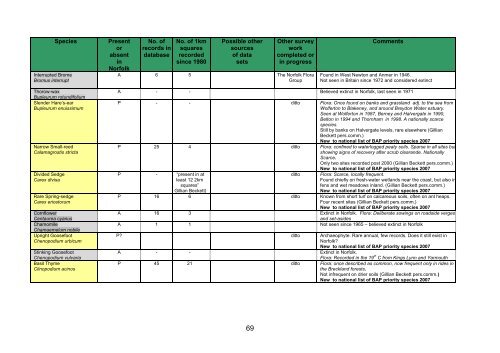NORFOLK BIODIVERSITY ACTION PLAN SPECIES DATA AUDIT ...
NORFOLK BIODIVERSITY ACTION PLAN SPECIES DATA AUDIT ...
NORFOLK BIODIVERSITY ACTION PLAN SPECIES DATA AUDIT ...
Create successful ePaper yourself
Turn your PDF publications into a flip-book with our unique Google optimized e-Paper software.
Interrupted Brome<br />
Bromus interrupt<br />
Species Present<br />
or<br />
absent<br />
in<br />
Thorow-wax<br />
Bupleurum rotundifolium<br />
Slender Hare’s-ear<br />
Bupleurum enuissimum<br />
Narrow Small-reed<br />
Calamagrostis stricta<br />
Divided Sedge<br />
Carex divisa<br />
Rare Spring-sedge<br />
Carex ericetorum<br />
Cornflower<br />
Centaurea cyanus<br />
Chamomile<br />
Chamaemelum nobile<br />
Upright Goosefoot<br />
Chenopodium urbicum<br />
Stinking Goosefoot<br />
Chenopodium vulvaria<br />
Basil Thyme<br />
Clinopodium acinos<br />
Norfolk<br />
No. of<br />
records in<br />
database<br />
No. of 1km<br />
squares<br />
recorded<br />
since 1980<br />
Possible other<br />
sources<br />
of data<br />
sets<br />
69<br />
Other survey<br />
work<br />
completed or<br />
in progress<br />
A 6 5 The Norfolk Flora<br />
Group<br />
Comments<br />
Found in West Newton and Anmer in 1946.<br />
Not seen in Britain since 1972 and considered extinct<br />
A - - Believed extinct in Norfolk, last seen in 1971<br />
P - - ditto Flora: Once found on banks and grassland adj. to the sea from<br />
Wolferton to Blakeney, and around Breydon Water estuary.<br />
Seen at Wolferton in 1987, Berney and Halvergate in 1990,<br />
Belton in 1994 and Thornham in 1998. A nationally scarce<br />
species.<br />
Still by banks on Halvergate levels, rare elsewhere (Gillian<br />
Beckett pers.comm.)<br />
New to national list of BAP priority species 2007<br />
P 25 4 ditto Flora: confined to waterlogged peaty soils. Sparse in all sites but<br />
showing signs of recovery after scrub clearande. Nationally<br />
Scarce.<br />
Only two sites recorded post 2000 (Gillian Beckett pers.comm.)<br />
P - “present in at<br />
least 12 2km<br />
squares”<br />
Gillian Beckett)<br />
P<br />
16<br />
6<br />
New to national list of BAP priority species 2007<br />
ditto Flora: Scarce, locally frequent.<br />
Found chiefly on fresh-water wetlands near the coast, but also in<br />
fens and wet meadows inland. (Gillian Beckett pers.comm.)<br />
New to national list of BAP priority species 2007<br />
ditto Known from short turf on calcareous soils, often on ant heaps.<br />
Four recent sites (Gillian Beckett pers.comm.)<br />
New to national list of BAP priority species 2007<br />
A 16 3 Extinct in Norfolk. Flora: Deliberate sowings on roadside verges<br />
and set-asides<br />
A 1 1 Not seen since 1965 – believed extinct in Norfolk<br />
P? ditto Archaeophyte. Rare annual, few records. Does it still exist in<br />
Norfolk?<br />
New to national list of BAP priority species 2007<br />
A - - Extinct in Norfolk.<br />
Flora: Recorded in the 19 th C from Kings Lynn and Yarmouth<br />
P 45 21 ditto Flora: once described as common, now frequent only in rides in<br />
the Breckland forests.<br />
Not infrequent on drier soils (Gillian Beckett pers.comm.)<br />
New to national list of BAP priority species 2007





